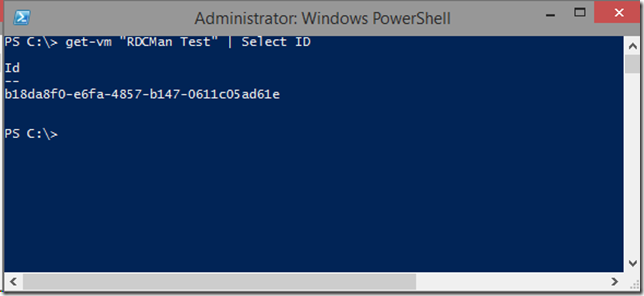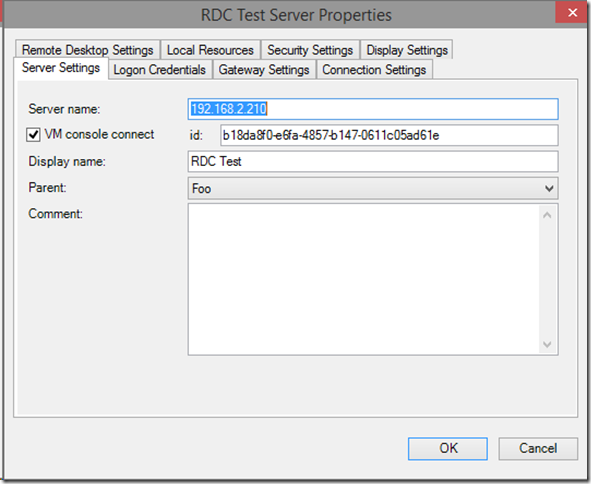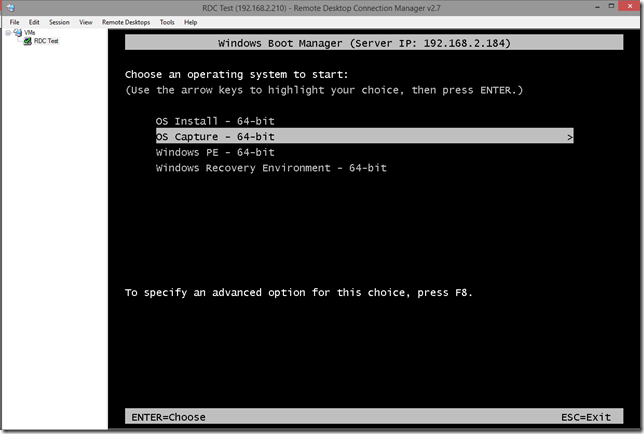Using RDCMan v2.7 to Connect to a VM
Yesterday, I posted about a new version of RDCMan – where one of the new features was the ability to connect directly to virtual machines. Since then, I have had a number of people ask me about how to actually make this work. So here we go…
The first thing you need is to know the virtual machine ID of the virtual machine you want to connect to. You cannot find this through the GUI, but it is easy to get using PowerShell. Here I am grabbing the ID for a virtual machine called “RDCMan Test” by running:
get-vm “RDCMan Test” | Select ID
Once you have the virtual machine ID, you can go over to RDCMan. Here you want to create a new server entry – as though you were going to use Remote Desktop to connect to a physical computer. You will want to put the address (or name) of the Hyper-V host in the Server name field. Then you want to check the option for VM console connect and enter the ID for the virtual machine, like this:
With all this in place – you will be able to connect to the virtual machine screen, just like you can with Hyper-V Manager:
Cheers,
Ben
Comments
Anonymous
November 25, 2014
Can this been done against a failover cluster?Anonymous
November 25, 2014
Will this work against a Linux guest?Anonymous
November 25, 2014
All our hosts are on a Failover Cluster, so I suspect that is why this is not working. I will test on a stand-alone server.Anonymous
November 25, 2014
Hi Ben, My Hyper-V host is Windows Server 2012 R2, RDCMan is on Windows Server 2012 R2 also. Error message [Unknown disconnection reason 3848]Anonymous
November 25, 2014
Hi, Ben. I want to connect to my VM on Windows 8.1. I get error: [Unknown disconnection reason 3848] ?Anonymous
November 25, 2014
It's a good improovment, but how i should use it with Hyper-V cluster?Anonymous
November 26, 2014
Doesn't work for me also: unknown disconnection reason 3848Anonymous
November 27, 2014
That is awesome! Yes, I am installing Ubuntu 14.04 in gen2 VM right now in RCMan v2.7. Copy/paste from the clipboard doesn't work for me?!?Anonymous
December 02, 2014
Since there's no way to specify a host or a cluster, I'm assuming this only works on local VMs? Not all that useful.Anonymous
December 03, 2014
I got this working with my 2012r2 Hyper-V cluster by entering the cluster name the the server name field, the VM ID as described and the real name of the server as the display name. NetoMeter - cut and paste wont work as despite it all being wrapped up in a Remote Desktop tool, under the hood it will be the same as connecting using 'connect' in Hyper-V Manager or Failover Cluster Manager. Still a useful tool and convenient way of managing all those connections.- Anonymous
February 27, 2017
Thank you!
- Anonymous
Anonymous
December 03, 2014
Thanks Kevin! Yes, this does work remotely / in clusters. You just need to put the host / cluster name in the Server Name field. Cheers, BenAnonymous
December 03, 2014
I'm still not having any luck. I think maybe because I don't have R2 yet. I'll try again once I get my cluster upgraded. Really loving the other RDCMan improvements. Subtle yet welcome changes.Anonymous
December 03, 2014
Still must be something else. I'm running 2012 R2 cluster. I have installed RDCman on a VM in the cluster. I can ping the cluster name and the VM I'm trying to connect to. I can use RDCman to connect directly to the VM. I can use RDCman to connect to individual nodes of the cluster. But it will not connect to the VM when I use the VM option. Immediately goes to a Unknown disconnection reason 3848. Server name= ClusterName, VM console connect= cut-n-paste of (get-clustergroup <vmname>).ID, Display name=<vmname>. No good. I've been using RDCman for years and the thought that I would be able to use it access my Linux VMs was exciting. I tried first with a Windows Server 2012 R2 VM target, and it just won't get to it. Tried others - still no go. The only thing I can think of is the way I am connected, but even that seems a stretch. My Hyper-V hosts are in an isolated LAN so I have a jumpserver. I (Windows 8.1) mstsc to the jumpserver (Windows Server 2008 R2). I have the older version of RDCman configured on the jumpserver. I use it to connect to the VM that has the new RDCman installed. From there, RDCman works as it used to in the past. It simply fails when I try to access a cluster-hosted VM. I don't have a standalone Hyper-V host to try.Anonymous
December 04, 2014
What rights should an user should have on the host/cluster? He is local administrator in the target VMAnonymous
December 09, 2014
I haven't had any luck connecting to a VM on a failover cluster. If I specify the cluster node where the VM is running, it works fine. If I change the host name to the cluster name, it says "The Server denied the connection". Curious why specifying the cluster works for some. The nodes are 2012 R2.Anonymous
December 10, 2014
I have no luck either. Single servers, no clusters. The error I'm getting is [Unable to establish a connection]. From the Hyper-V Manager, I have no problem connecting. Would love to have the capability.Anonymous
December 10, 2014
I found this for the ones that have the 3848 error: myitforum.com/.../rdcman-v2-7-unknown-disconnection-reason-3848 Don't know if it's a resolution, may be a start.Anonymous
December 27, 2014
===> Found solution to error 3848 Hi All, I had the same issue [Unknown disconnection reason 3848] when I tried to connect to my Hyper-v guest which is configured with "INTERNAL VIRTTUAL NETWORK" I followed both the workaround in the KB: _support.microsoft.com/.../954357 which helped me solve the problem. NOTE: Make sure to EXPORT the registry hive to be on the safer sideAnonymous
January 15, 2015
This isn't working for me. Windows 8.1 Client Hyper-V single VM instance.Anonymous
January 24, 2015
I can confirm that adding the following registry keys, will solve the problem for 3848 error: myitforum.com/.../rdcman-v2-7-unknown-disconnection-reason-3848Anonymous
January 24, 2015
Charbel - That looks right to me - to all the people hitting problems, please try the fix recommended in the post above this.Anonymous
February 12, 2015
myitforum.com/.../rdcman-v2-7-unknown-disconnection-reason-3848 and support.microsoft.com/.../954357 doesn't work for me. I have Hyper-V 2012R2 clustered and nonclustered servers in domain and standalone Windows Server 2012R2 Server...Anonymous
February 19, 2015
I can confirm that there are some issues regarding the VM console connection. I have 3 Hyper-V 2012R2 servers, 1 is stand alone the other two are clusters all in the same domain. From a Windows 7 machine with RDCman 2.7 trying to connect to the vm to the stand alone server works well. From a Windows 7 machine with RDCman 2.7 trying to connect to the vm on the cluster using the host that has the vm role active, it also works From a Windows 7 machine with RDCman 2.7 trying to connect to the vm on the cluster using the cluster name, I get "The server denied the connection" When I install RDCman on the standalone Hyper-V 2012R2 server, and try to connect to one of the vm's using RDCman's vm console connection of a VM running on the cluster (using the cluster name) I get the error "Unknown disconnection reason 3848" After applying the registry keys for CredSSP no changes.. After some more testing, it seems the "The server denied the connection" only occurs when you try to connect to a VM that is not hosted on the cluser node that has the status "Current Host Server" in the Failover Cluster Manager. So if I wanted to spread the load of my VM's I am unable to connect to half of them. VM's hosted on the current host server seem to connect just fine. During a failover, where all VM's are moved from one host to another, I'm unable to connect to any VM in the cluster using this method. Also, it appears the Hyper-V management tools from RSAT are required in order to be able to connect? Since I'm not able to get it to work without them installed. Eventhough for Windows 7 the Hyper-V management tools cannot be used to manage 2012R2 servers. Love the new features, but this one in particular could use some attention.Anonymous
March 28, 2015
Is there a way to make this work with VMware ESXi VMs?Anonymous
April 13, 2015
I receive the below message when running PS P:> get-vm “RDCMan Test” | Select ID get-vm : The term 'get-vm' is not recognized as the name of a cmdlet, function, script file, or operable program.Anonymous
May 12, 2015
What if you are using a W8.1 in workgroup and your Hyper-V are stand alone server in a domain? Or for connecntion to a cluster from a workstation in 8.1 in workgroup?Anonymous
May 18, 2015
Any idea if we can make this console connect work with ESX/vSphere?Anonymous
May 19, 2015
The comment has been removedAnonymous
May 19, 2015
The comment has been removedAnonymous
June 02, 2015
I am hitting the 3848 error however neither the CredSSP resolution or the Visual C++ Redistributable have resolve it. This is a fairly fresh install of Windows 8.1, so it is fairly Vanilla still. Is there any place where I can take a look at logs and dive a little deeper into this?Anonymous
June 22, 2015
at my home PC it works fine but from 2 laptops it doesn't work even if system was installed from scratch I've tried to install VC++ 2012 x86 and x64 but no effect I've tried to add registry keys on host machine, although all works from home PC without these and still no success I don't understand what's wrong...Anonymous
June 22, 2015
at my home PC it works fine but from 2 laptops it doesn't work even if system was installed from scratch I've tried to install VC++ 2012 x86 and x64 but no effect I've tried to add registry keys on host machine, although all works from home PC without these and still no successAnonymous
June 27, 2015
FAIL! None of these suggestions will work. I have Hyper-V running on a Server 2012 R2 system. I try to connect to my VMs from a remote PC (on the same domain) and get unknown disconnection reason 3848. All of these suggestions are failures.Anonymous
July 07, 2015
Hello guys I can't get the id of my vm I don't know what I'm doing wrong.Anonymous
July 07, 2015
I got it guys, I was running the cmdlet on my vm not on my host.Anonymous
July 15, 2015
If anyone is having trouble connecting, (just getting "Unable to establish a connection") here is a critical part that I missed in Ben's post above: "You will want to put the address (or name) of the Hyper-V host in the Server name field. " Now that I fixed that, I am getting the 3848 reason and working through that issue.Anonymous
September 16, 2015
Thanks for this post but I just can't seem to get it to work. I've obtained the VM ID, although on my ESXI 6 it's returning "VirtualMachine-16" instead of the hex number in the example above. In any case, I just get "unable to establish connection"...Anonymous
November 12, 2015
I agree with Stephan Schwarz about how this needs some work when using the VM Connect feature to connect to a Hyper-V cluster. If I specify the host that is currently hosting the vm along with the VM ID it works fine. If I specify the cluster address or the machine has moved to another host in the cluster I get "The server denied connection". Given the fluid nature of the machines in a failover cluster due to cluster aware updating these machines will move in the cluster. This of course is not an issue with direct RDP, just the VM console connect. Of course those running ESX this will not work.Anonymous
November 16, 2015
If you want to connect to VMs those are hosted on your local computer - you need to mention your
- local host name in "Server Name" field then VM Console connect ID.
- VM Console connect ID can be acquired by running command on local host using power shell >> Get-VM "name of VM under hyper-v manager" | select ID
- under logon credential check "inherit from parent" then try to connect. it'll prompt you for VM password. that is it. you can connect. Hope this helps!
- Anonymous
January 24, 2016
The comment has been removed- Anonymous
April 15, 2016
For all those trying to VMConnect to cluster guest, here's my solution. Created PowerShell script:param([string]$vmname)$vm = get-vm $vmname$vmhost = $vm.vmhostvmconnect $vmhost $vmnameThis script must be used within the VMM PowerShell console and will open any guest VM without knowing the host it's on.
- Anonymous
- Anonymous
May 23, 2017
Hi,whats about Hyper-V on Server on Windows 2016? is it supportet by rdcman 2.7?i've tried to connect to VM, but with no luck.thank you - Anonymous
September 19, 2017
it did not work with me, with message unable to establish a connection.May be it's need PC which have RDCMan to be join to domain ?


